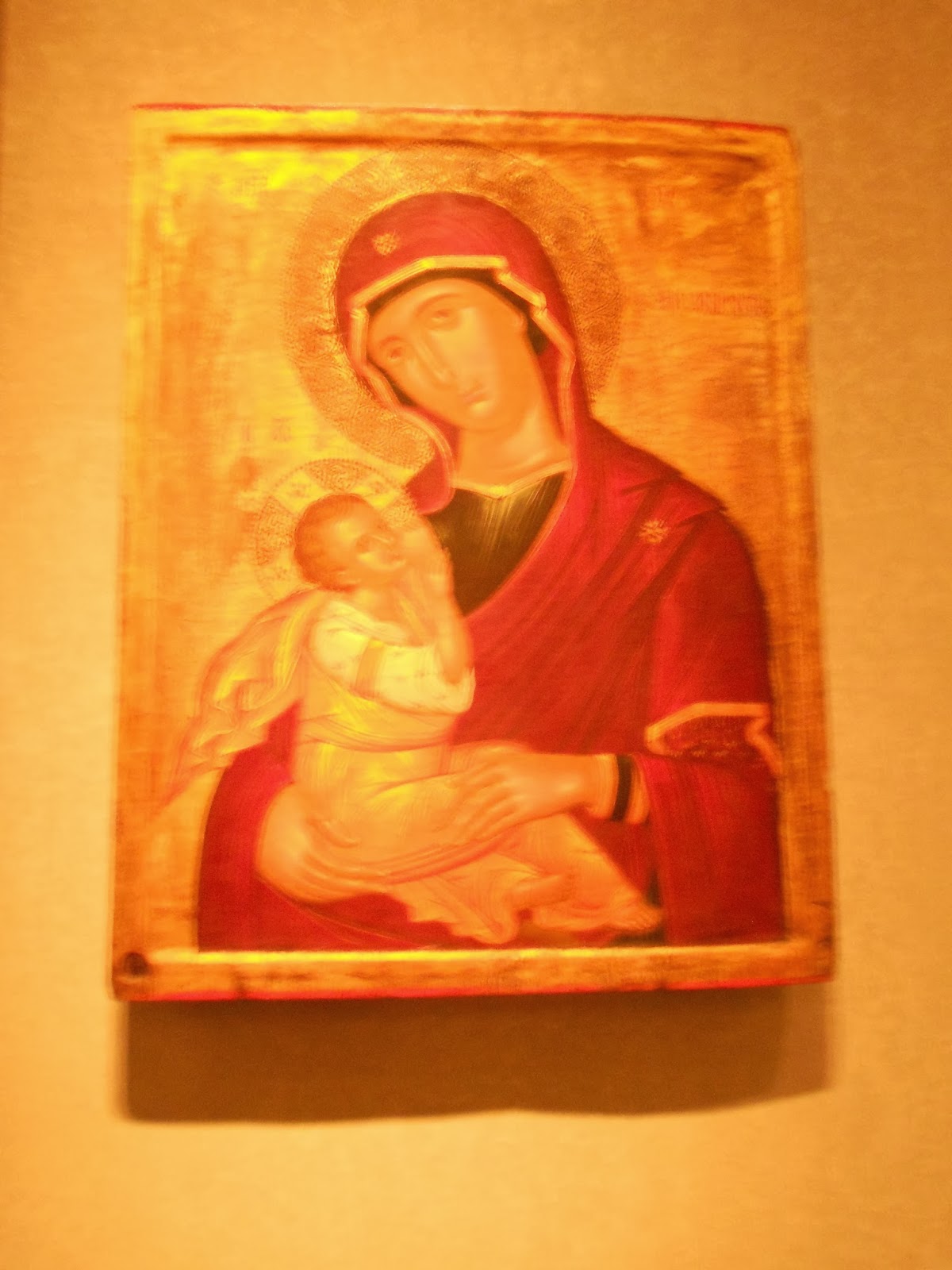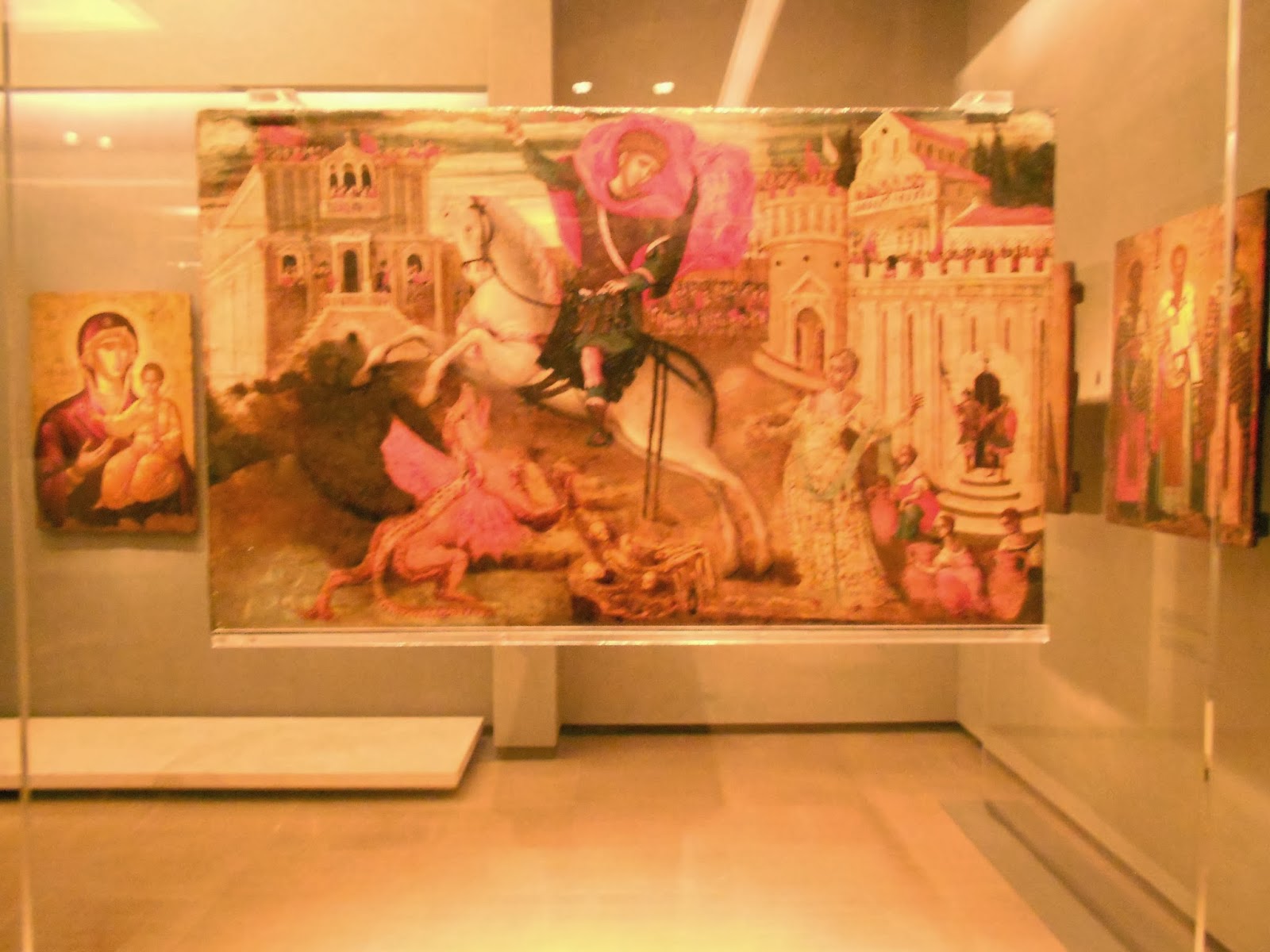Epigonation (literally meaning "over the knee", a vestment used in some Eastern European churches) depicting Christ as the Angel of Great Counsel, 17th century.
The Trial of Christ, early 19th century.
The Wisdom of God in the Kiev type, Kerkyra, first half of the 19th century.
Glass vessels, 5-6th century.
Clay unguentaria from the 2nd-3rd century, glass unguentaria, for perfumes and cosmetics, from Tigani in the Pelopponese, 6th century.
Copper pectoral crosses with suspension ring, 6th-8th century.
Copper polykandelon (lamp holder) ring with votive inscription, from Limni in Euboea, 6th century.
Parts of a mosaic floor from Athens (Ilissos Basilica), 5th century.
Stork motif with twisted rope border.
Geometric motif, again surrounded by the twisted rope border.
Another bird motif, possibly a stork.
Laurel leaf wreath motif in twisted rope border.
Original layout of the floor found in the basilica.
Piece of wool fabric with geometric designs, 6th century.
Pieces of wool, linen and silk garments decorated with woven and embroidered themes, 4th-8th century.
Pieces of wool and linen garments decorated with woven representations of sacred figures and themes of fauna and flora, 4th-8th century.
Coptic icon with an archangel, 17th century.
The manuscript is an exact copy by the painter Demetrios Nikolianos, created with the assistance of the conservator Vassiliki Papakosta. Manuscript parchment scroll with the chrysobull of the emperor Andronikos II from Monemvasia, 1301. The chrysobull was issued by Andronikos II (1282-1328) to confirm and augment certain privileges enjoyed by the Metropolitan of Monemvasia, Nikolaos (1283-1325). At the top of the document is a miniature showing the emperor giving the chrysobull to Christ. At the bottom the signature of the emperor in red ink. Chrysobulls were imperial documents granting privileges and derive their name from the gold eal (chryse boulla) with which they were stamped and sealed.
Marble closure slab with relief decoration, late 9th century.
Parts of marble doorframes with relief decoration, 10th-12th century.
Marble lintel with two-level relief decoration, from Athens, 12th century.
Marble closure slab with the Tree of Life between two sphinxes trampling upon a deer in two level relief, 12th century.
Marble closure slab with spiral interlacing design, eagle described in a wheel, 10th-11th century.
Bilateral marble closure slab decorated with relief Tree of Life, between lions. Floral pattern on the frame, from Athens, 11th-12th century.
Part of marble screen architrave with relief decoration on the main and lower sides, 10-11th century.
Marble closure slab with relief composite interlacing design and rosettes, from Athens, 11th century.
Marble closure slab with relief decoration, from Athens, 11th century.
Part of a wall painting with the Pentecost, 13th century.
Marble closure slab with lyre shaped relief decoration, late 9th century.
Marble closure slab with relief decoration of interlacing band forming lozenge shaped pattern, 10th-11th century.
Marble closure slab with relief decoration of interlacing bands and Greek cross inscribed in the disc at the centre, 10th-11th century.
Parchment manuscript Book of Gospels with illuminations representing the four Evangelists and ornamental headpieces, from Adrianople, 14th century. The binding dates from the 18th century.
Gospel from the printing house of Giacome Leoncini, Venice 1500.
New Testament published by Stephanus Royal Printing House of the Estienne, Geneva 1582.
Parchment Gospel from Timios Prodromos Monastery, 13th-14th century.
Icons showing the Virgin and child, 15th-16th century.
Icon with Saint George Dragon-Slayer, 16th century.
Icon of Saint Catherine, mid 17th century.
Drawing with the Leone di Saint Marco and coat of arms from Corfu, 19th century.
Epigonation (genual) with the depiction of Christ in a Glory surrounded by orders of angels and the symbols of the Evangelists; in the corners God the Father, the Holy Spirit and prophets. Embroidered by Despoineta of Argyris, 1689.
Hanging for a royal door with a representation of Hypapante. Embroidered by Kokona of Rologas, 19th century.
Velvet sakkos with gold-embroidered foliate decoration. From Bursa, Asia Minor, 19th century.
Icon of Saint Marina and scenes from her life in Cappadocia, Asia Minor, 1851.
Icon with Saint Christopher "Cynocephalus", from Asia Minor, 1685.
Glazed ceramic wares from the Iznik workshops (Nicaea), circa 1600.
Manuscript with spells, cryptic inscriptions and medical advices, 18th century.
Manuscript with exorcisms, 18th century.
Manuscript with pages of alchemical interest, 18th century.
Hanging for a royal door depicting a baptism. Embroidered by Demetrios, 1846.
Liturgical code written by the scribe Anthimos, pupil of Loukas of Cyprus, Bishop of Buzau, 1633-4.
Liturgical manuscript (lectionary) in luxurious binding, gift from the voyvod of Wallachia, John Matthew Bassaroba, to the Ecumenical Patriarchate in Constantinople. It is decorated with full page illustrations of the donor and his wife. Written by the scribe Anthimos of Ioannina. From the Monastery of the Dormition of the Virgin Petritziotissa in Bachkovo (now part of Bulgaria), 1644.




































































1 comment:
Could you please tell a bit more about the images of a floor with twisted rope ornaments.
How old are those floors?
Post a Comment